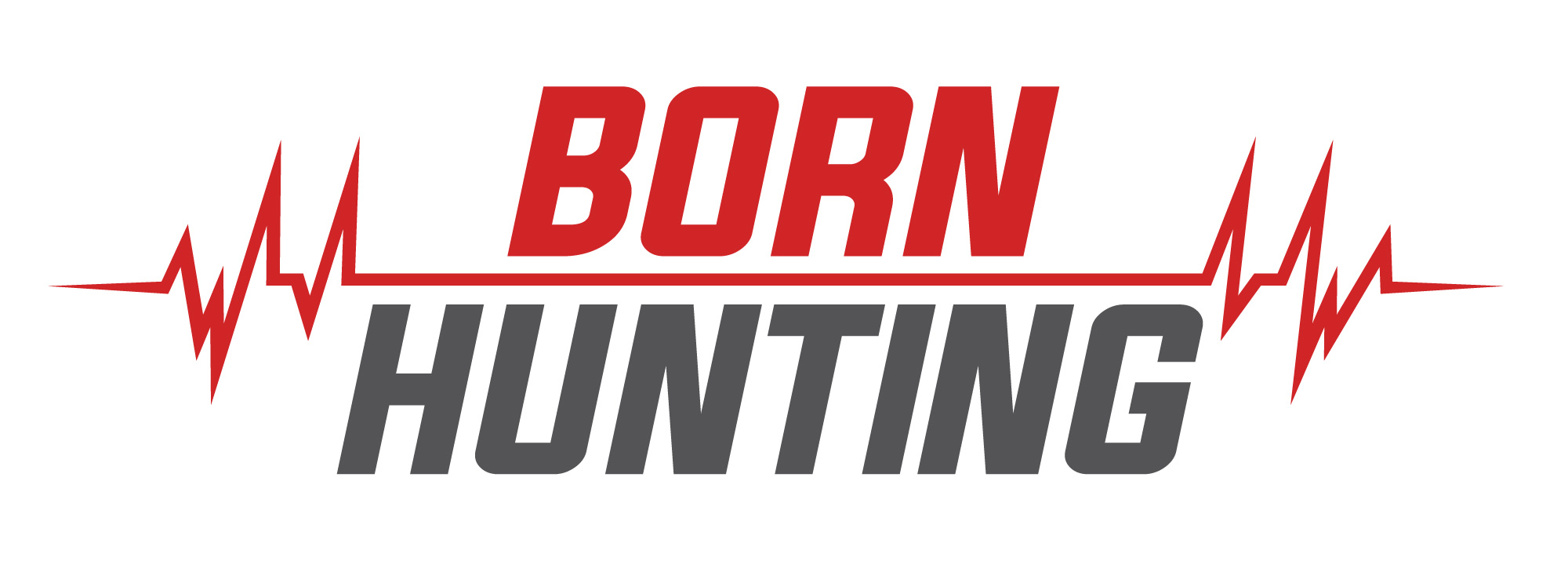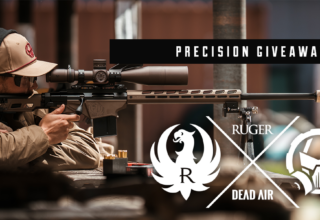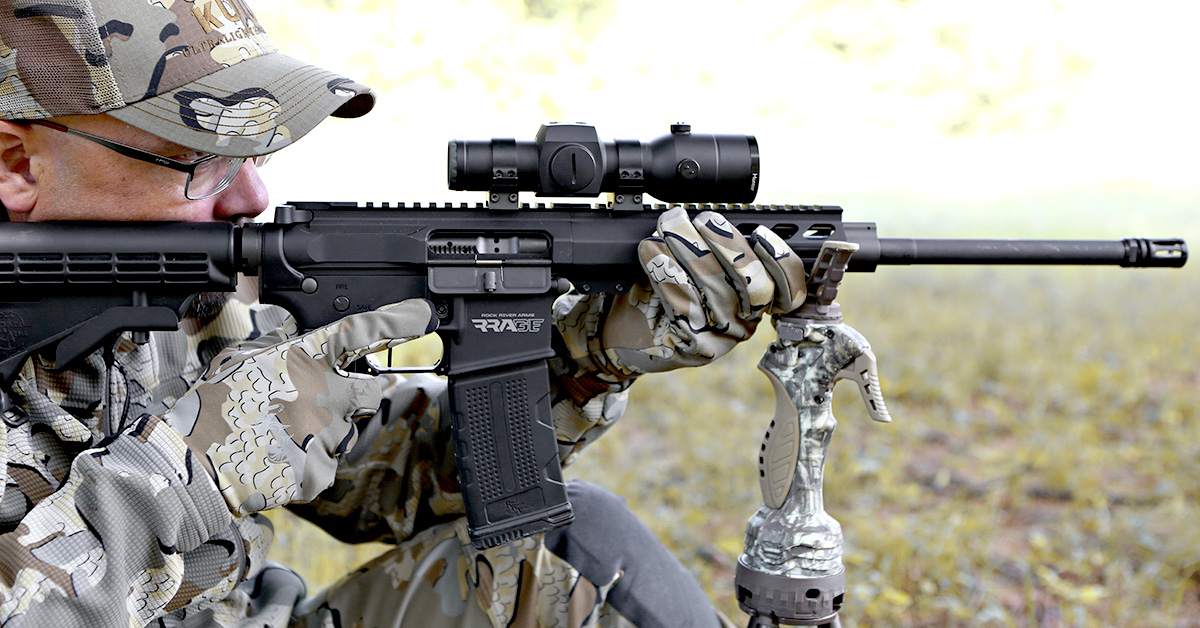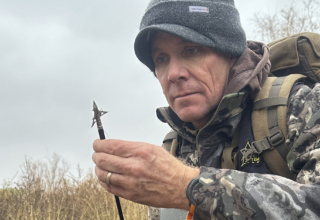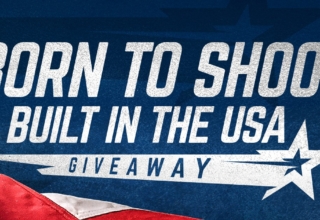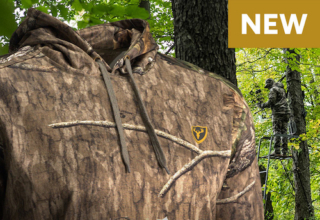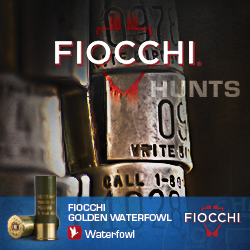Pulling down feisty toms in wide open country can be a genuine big game adventure…especially when you’re running with “get-it-done” gear
by Rob Reaser; photography by Olstad Media and Rob Reaser
I certainly wouldn’t have voiced my thoughts to my two companions as we climbed a wickedly steep slope rising up from the cottonwood river bottom, but I was feeling more than a tad remorseful. The evening prior, I had muffed the opportunity to make a layup shot on a South Dakota tom and now, sweating and huffing our way up to the flattop where we’d parked the truck, both the pressure and the regret was beginning to build. Pressure because I had two tags to fill and two days to do it; regret that I hadn’t pulled the trigger a little more than 12 hours earlier when I had the chance.
It was a weird thing that happened the previous evening…something I don’t recall ever having experienced. I was “bead on” at a gobbler not 30 yards away — drawn in with fan and call by Born Hunting‘s own Director of Sales Toby Shaw — and I couldn’t pull the trigger.
We had stopped the truck on top of a cedar-dappled ridge flanked by dark, evergreen-choked canyons and fell out of the pickup with no great expectation of hearing anything over the persistent sweep of 20-plus mph winds. Yet hear something we did, and not 200 yards away.
Toby and I turned to each other with that knowing, “There’s one!” look in our eyes and made a quick jaunt in the gobbler’s direction. As we neared the final approach, our two companions followed tight behind me and Toby, who screened our profile with a fanned decoy. We were crouch-walking up a slight rise when Toby motioned everyone down. The gobbler sounded off, and he was close…like “right there” close. But I couldn’t see him, My eyes did, though, lock onto the hen that nervously walked the edge of the ridgeline about 75 yards in front of us.
“Take him. Take him.” Toby whispered sternly over his diaphragm call.
“Take what?” I thought. I could see no gobbler, so I slid my head around the other side of the decoy fan and caught the movement of a turkey noggin not 20 yards in front of us. I drew up on my knees and shouldered the Franchi Affinity 3 Turkey Elite, tracking just below the bird’s head with a Burris Fastfire 4 red dot.
“Shoot him!” Toby said.
“Smoke him!” our buddy Keith advised over my shoulder.
The sun, setting in the distance, backlit the tom’s engorged, cherry red wattle. Yet he wasn’t fanned out and he wasn’t gobbling. I couldn’t even see a beard. Whether it was my subconscious telling me I hadn’t made a clear target identification or something else holding me back, I can’t say. All I know is that I had this uncertain feeling about pulling the trigger. And so, I didn’t.
The bird quickly got wise and trotted away at a stiff clip; up and over the hill he went. I’m sure that my hunting companions probably felt like pitching me over the hill as well.
So it goes.
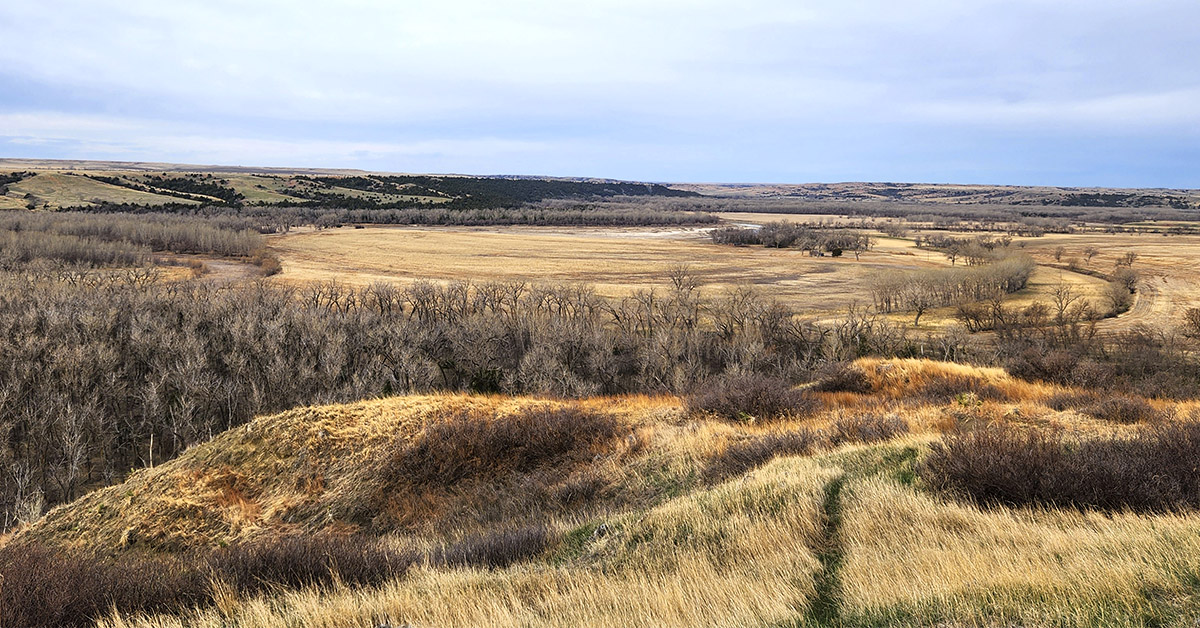
Nature is beauty for those who know how to see it, and South Dakota certainly delivers an eyeful. In early spring, the tawny prairie grass, accented by the green haze of new growth bursting forth and mixed with craggy cottonwoods and stunted cedars under rich, blue skies command respect and thankfulness for His creation. Of course, the weather can run between the extremes, with frigid temps and snow one day, clear and warm the next. Part of the game is knowing what the birds do in all conditions. High winds (of which there are plenty) mean the birds are tight to the leeward side or deep in the pines. Identifying the frequent roosts and the daily drift between feeding and roosting areas saves precious gasoline and boot leather. But such is the case most anywhere the wild turkey roams.
In South Dakota, spot-and-stalk provides the true adventure. With visibility measured in miles rather than yards, hunting prairie turkeys is more akin to pronghorn or mule deer hunting. Get up high, hit the glass, and once you find them, make your move.
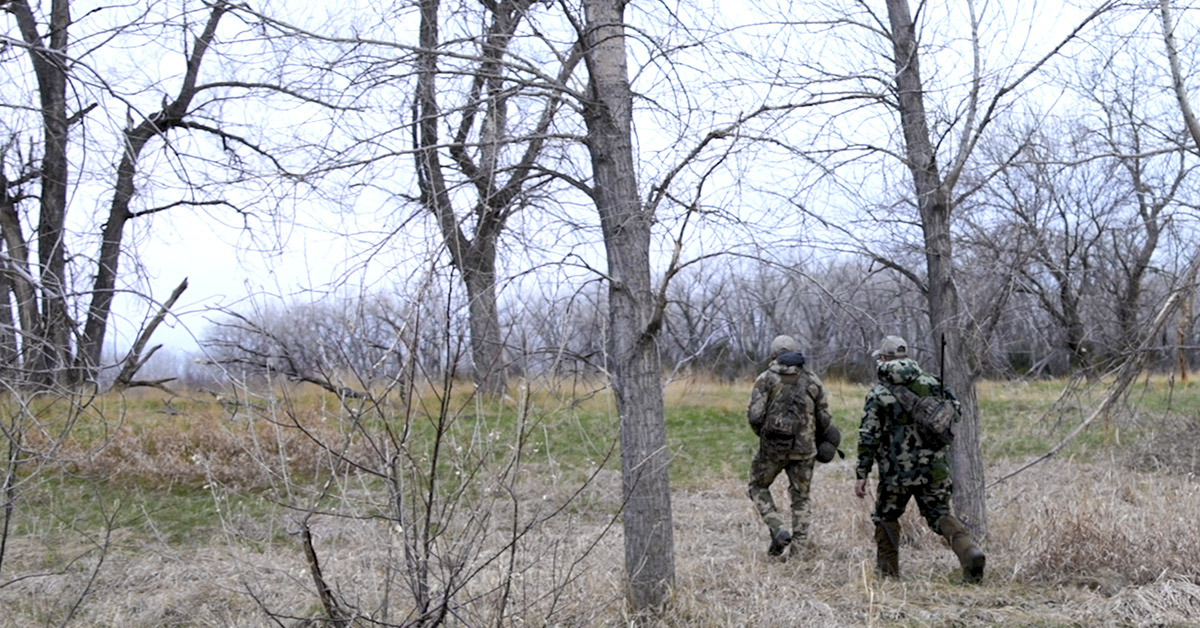
After a solid hike at daybreak on the second day and with no turkeys located, we headed to a different stretch of river bottom where visibility was more limited. The long expanses of deciduous trees and interspersed ag land, though, held promise. In short order, we were teased by a group of gobblers sounding off somewhere to the north. The problem was, we did not know if the birds were on our side of the river. Long, sweeping curves and aggressive oxbows meant they could favor either shore. So, we made a best guess that they were on our side and moved in to call.
Sliding through thick river bottoms is no easy matter if stealth is priority. The relatively dry climate makes for noisy twigs underfoot…all the more unavoidable when covered in last year’s dead grass. Snaps and cracks aside, we set up near an opening in a thicket that we guessed to be around 150 yards from where the birds were located. This time, my good friend Ken was expertly manning the calling and fanning duties while I hunkered beneath a small cedar with the 20-gauge Franchi at the ready.

Alternating between box and mouth calls, Ken got the gobblers’ attention and within a few minutes they were shifting in our direction. Closer and closer they came and then…they moved to our left, coming no closer yet gobbling with increasing agitation. It was as if they hit a force field around us. That was when we realized they were hung up on the other side of the river.
“Let’s ease our way toward them and see if we can get them to pitch over the water,” Ken whispered.
Walking crouched through the crackling understory, we cleared the thicket and belly crawled through the dead grass lining the riverbank. By this time, the birds were well downstream of us, and we were without options.
Back to the truck.
For the next couple of hours, we poked and prodded the prairie to turn up some more birds to chase, but with no success. The turkeys were chilling somewhere out of sight and weren’t in a talkative mood. Our attention thus turned to our stomachs and the lack of anything in them. We hadn’t planned to be out all day, so lunch would consist of whatever snacky items were hiding under the truck seats or in the door pockets. The pickings were slim. Fortunately, hunger is one of those things that often subsides when you are on the hunt. I can usually go all day without eating if I’m in the field. Put me behind the desk and I’m watching the clock in anticipation of my next meal!
After several more miles under our treads, our meandering afternoon journey put us on a high flattop a mile or so downstream of where we left that batch of gobblers earlier in the morning. Ken spotted them again at the tail end of the woods lining the riverbank. There were about five gobblers in the group, and they were in a chatty mood.
They were also still on the “wrong” side of the river.
We sat in the truck, pondering what to do.
“I think we can cross the river and get to them,” Ken said.
“Where’s the bridge?” I asked.
“There isn’t one.”
Ugh. I knew where this was going.
I have two real hangups: heights and water. I once nearly blacked out from a panic attack while trying to climb into a ladder stand. Get me too near a steep drop off and I get this unbalanced feeling and have to scoot back to “safety.” Big water is also a big fear for me since I never learned to swim effectively. So, here I am, looking down into this valley, watching the wide, murky river winding menacingly below me.
Wind ripples the chocolaty sheen, reflecting a blue sky harassed by gathering clouds. The sun inches closer to the western horizon.
No one speaks. Wind gusts through the rolled-down truck windows. A half-mile away, the occasional gobble drifts up from the valley onto the flattop where we sit. Tempting. Teasing.
They are waiting for me to decide. So are my hunting companions.
“Let’s do it,” I said with all the false bravado I could muster.
“That’s what I’m talking about!” yells Ken as he slaps the dashboard. “Let’s get down there and we’ll find somewhere to cross. I have two pairs of waders in the back.”
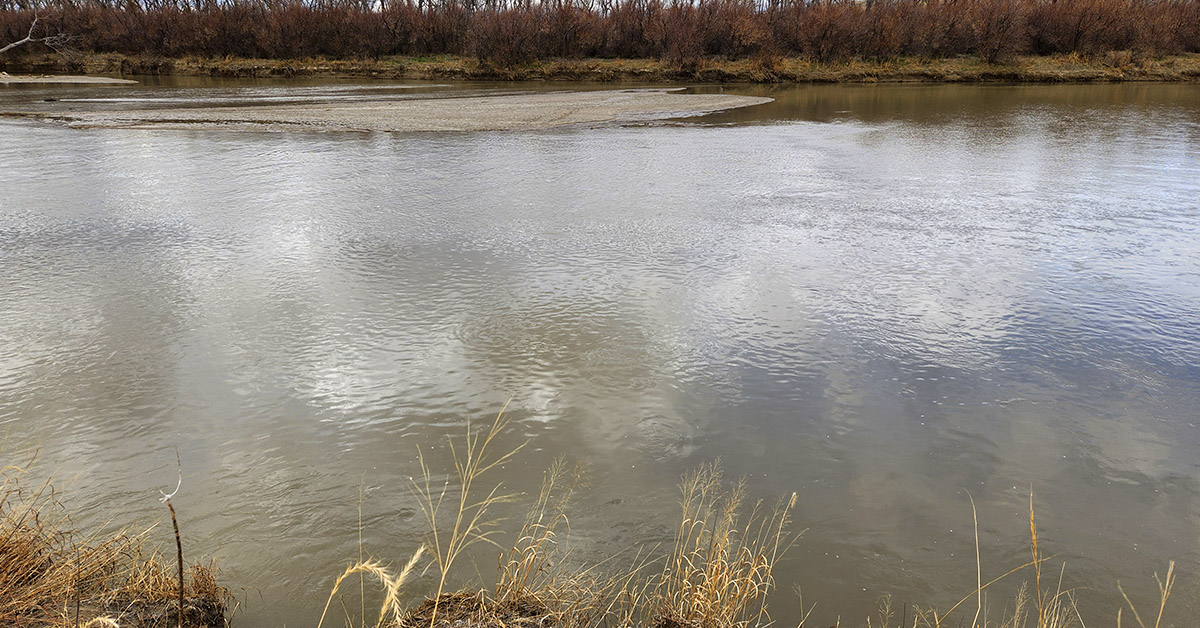
We parked the truck near the river, perhaps three-quarters of a mile downstream of the turkeys. No spot looked to me to be a good crossing choice, but Ken settled on a stretch with a sandbar in the middle. Seeing a little bit of exposed ground between me and the other bank did little to ease my qualms about hopping in flowing water with no visible bottom, but it was too late to turn back now.

Once on the other side, we traded waders for hunting boots and headed toward the birds. When Ken hit the box call to get their location, the chorus erupted about 100 yards away. We closed the distance on hands and knees, and then belly-crawled the final stretch to where the ground rose to the edge of an ag field.
While photographer Nate and I kept our faces in the grass, hoping no ticks crawled into our ears, Ken began to work the decoy fan, yelping confidently and excitedly. Two of the toms took the bait and began to strut right through the group of hens, heading our way.
Since I only had one day of hunting left, I was hoping to pull off a double with this set. My confidence ran somewhat optimistic as shooting doubles is not uncommon when fanning in these Merriam-Rio hybrids.
For seven minutes we laid in the grass, hearts beating harder and faster with each approaching gobble.
“Get ready,” Ken whispered.
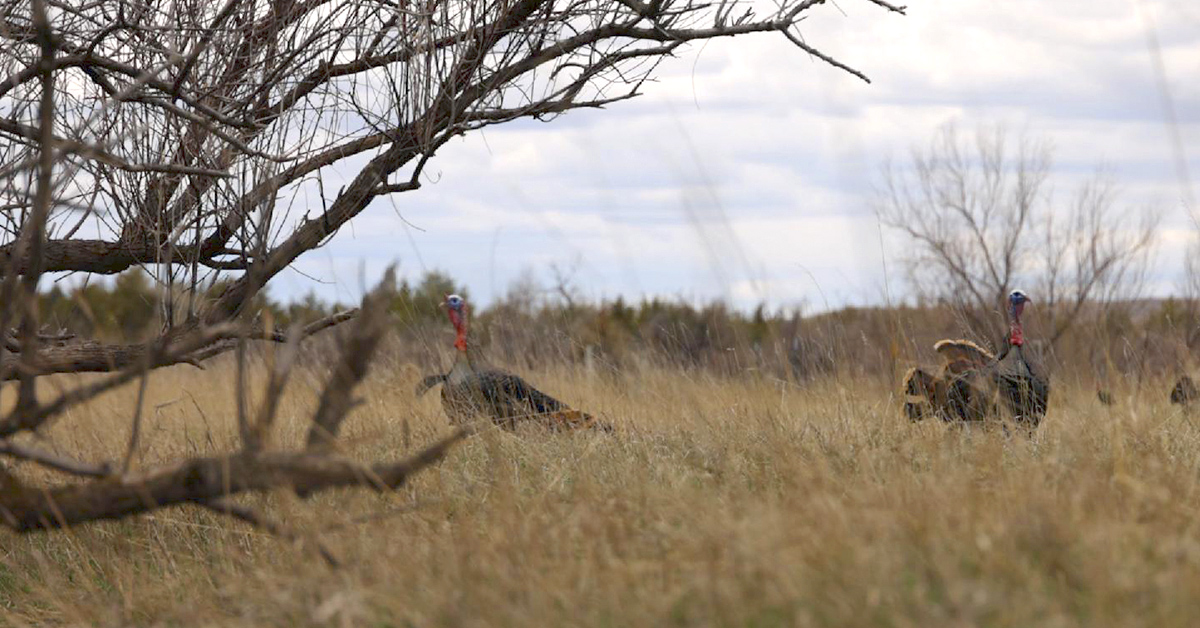
The birds sounded off and they were so loud I thought they were right on top of us. I couldn’t see them, though, so I focused on the one gobbler I could see about 40 yards to my left.
“Ok, NOW!” Ken said.
I pushed up onto my knees, simultaneously shouldering the Franchi and looking for my target. The two gobblers were about 25 yards away, the downed limbs of a cottonwood between us. For a split second I hesitated, calculating the size of the hole I had to shoot through to get on the biggest bird to the left. From experience, I was confident that the Fiocchi Golden Turkey TSS ammo would punch through any of the small twigs that might get in the way, so as the bird stepped into a semi-open lane, I pulled the trigger and the big tom dropped. The second bird didn’t run, but instead stepped over to see what was going on with his buddy who was flopping on the ground. It was a step too far when he passed by another hole in the downed tree branch. The Franchi/Fiocchi combo did the deed and both birds expired where they had stood, wings touching.
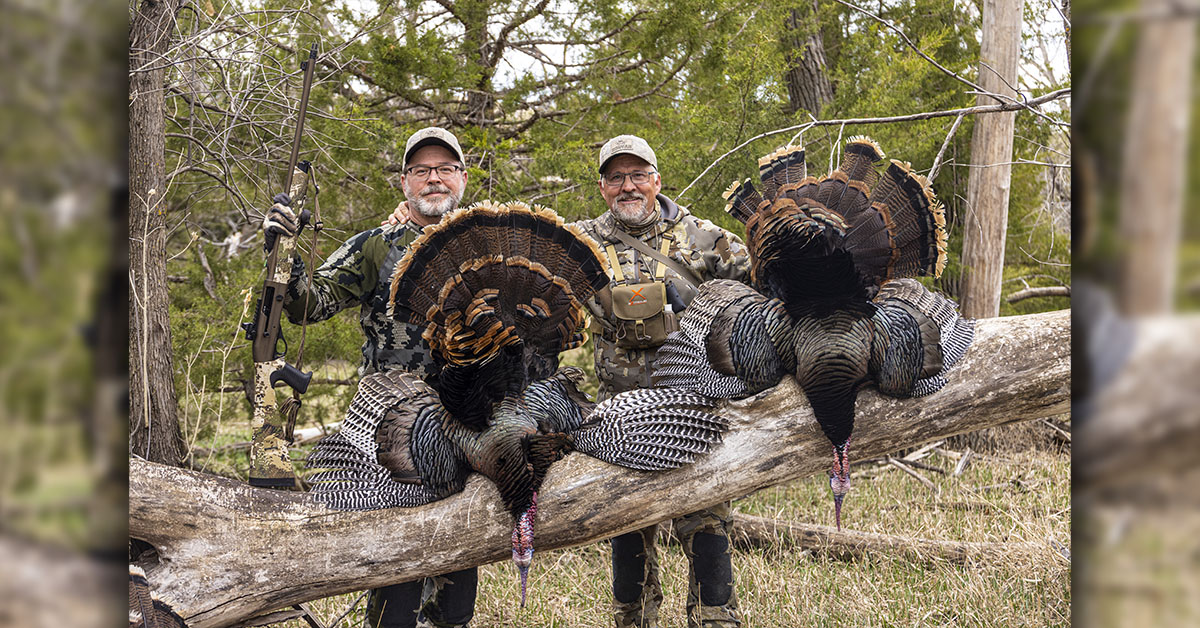
This was my first time going after turkeys with a 20-gauge, but the easy handling of the Franchi Affinity 3 Turkey Elite and the decisive smackdown of Fiocchi’s 3-inch #9 Golden Turkey TSS load proved their mettle. In truth, after years of abusing myself with magnum loads in my 12-guage turkey guns, I must admit that this experience may have tipped my preference to the 20-gauge/TSS combo. The lighter barrel weight and sweeter balance of the 20-gauge are absolute assets when the hunting conditions are on the “challenging” side of the scale. And the lighter recoil is, well, definitely worth the price of admission. Throw in the delicious knockdown power of the TSS load and the dense shot column offered (the 40-yard pattern on my pre-hunt test and red dot zeroing was TIGHT!) and it makes you question the argument for carrying a bigger stick.

Buoyed by a double-knockdown hunt and the shared experience among friends, it was time to face my nemesis once again — this time, with a couple of fine South Dakota birds wrapped across our shoulders. My chest waders managed to take a drink before reaching the home shore, but it was all good. Even though it was turkeys on the hit list, the effort required and the time it took to get these birds were on par with bigger game animals I’ve pursued west of the Mississippi.
If you can’t get a kick out of that, you ain’t livin’!
The Essential Gear
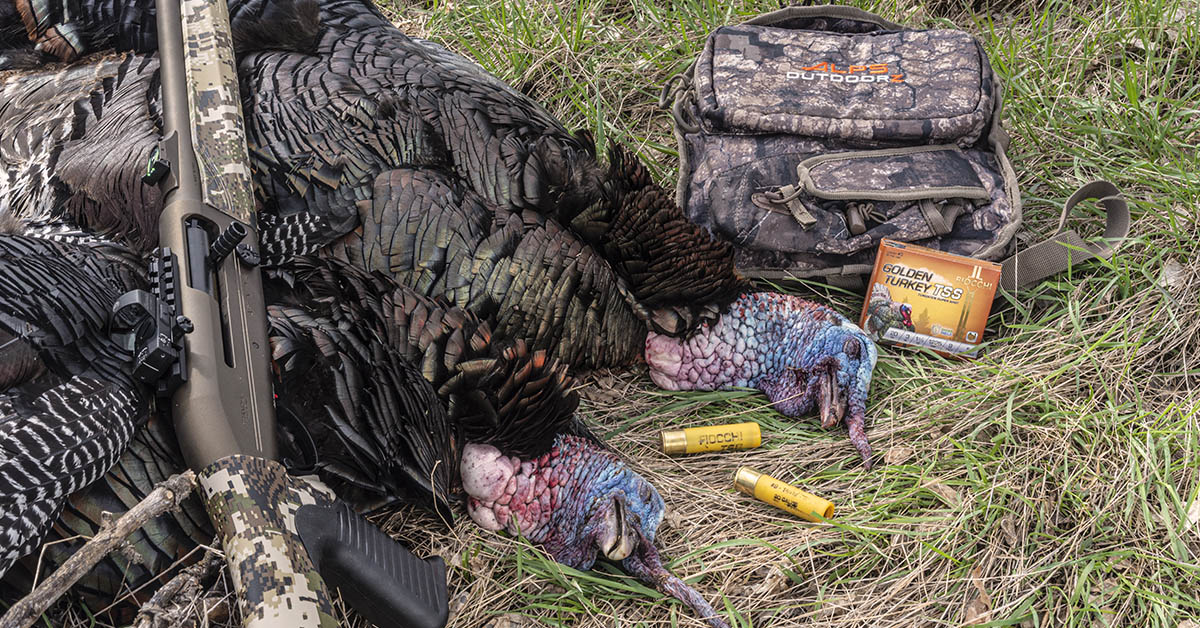
The gear we choose, as we all know, can be the deciding factor of any hunt’s success. For this prairie expedition, Franchi’s Affinity 3 Turkey Elite shotgun and Fiocchi’s Golden Turkey TSS ammo were the stars, with supporting roles going to the Bushnell Fastfire 4 red dot, ALPS OutdoorZ Ambush Sling Pack, and Dryshod’s Destroyer Protective Brush Boot.
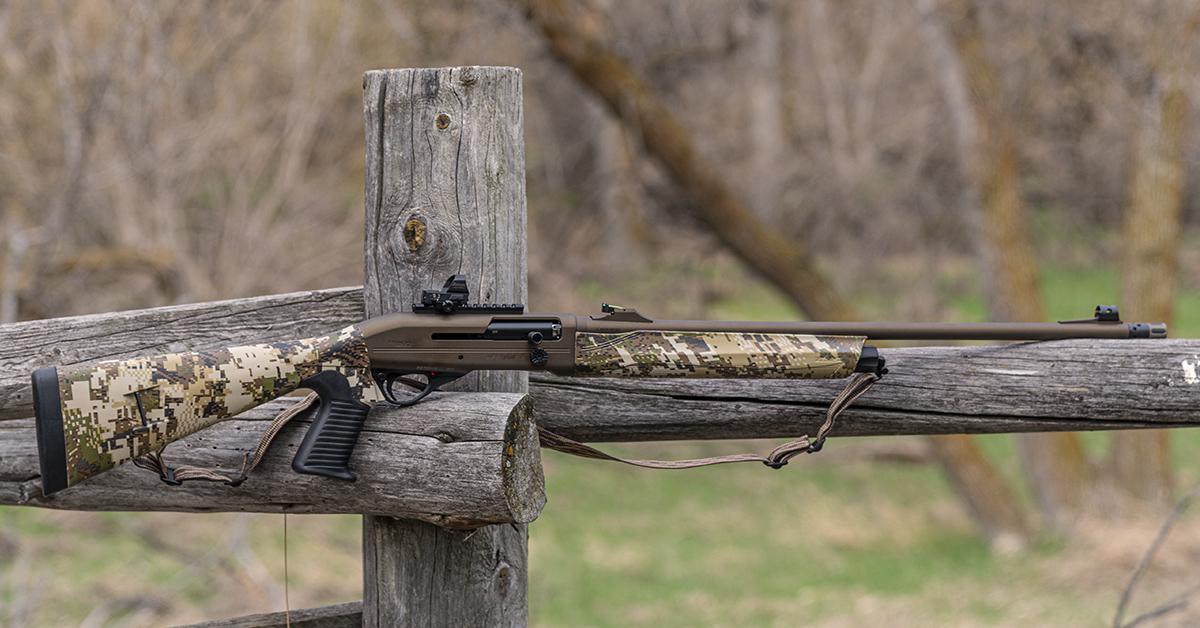
If you’ve never had the opportunity to shoot one of Franchi’s Affinity series shotguns, you’re missing out, as the ergonomics built into this semi-auto hits all the right notes. The pistol grip provides a comfortable at-ready hold when waiting for an approaching gobbler, and it makes for quick mounting. I especially appreciate the long, scalloped groove in the forend as it delivers a positive and comfortable support hand grip. Texturing along the foregrip is a blessing when wearing gloves.
Because the Affinity 3 Turkey Elite is designed to meet the needs of turkey hunters, it comes with high-visibility front and rear fiber optic sights — adjustable, of course, for windage and elevation. Precise sight alignment is important when firing dense-pattern loads like TSS.
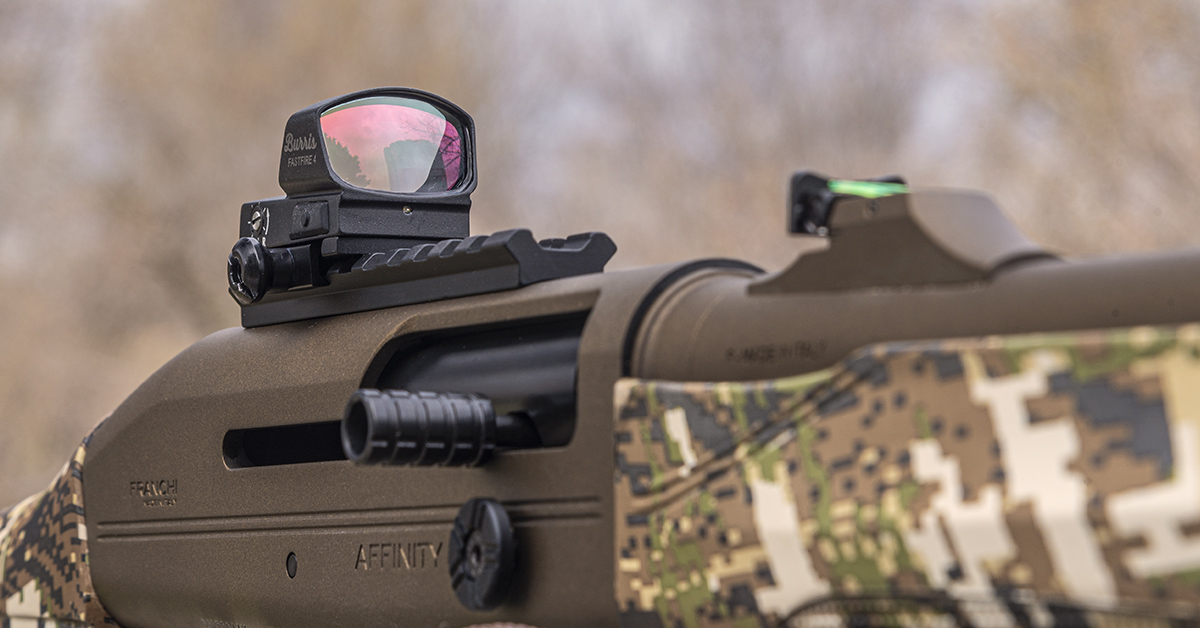
For those who opt for a red dot (a smart move when shooting TSS at close distances), the shotgun comes with a Picatinny rail mounted to the receiver for no-hassle optic installation. Our optic choice for this hunt was the Burris Fastfire 4. I like this model for shotgun work because of its large sight window, which ensures an uncluttered and expansive sight picture that is ideal when you’re quickly picking out your tom on the move. I also favor the Fastfire 4’s simple operation. One button allows to you switch between three manual brightness levels while an automatic setting is reactive to ambient light, meaning it automatically lightens or darkens with changes in available light.

Up front, the Affinity 3 Turkey Elite sports one of two Rhino extended turkey choke tubes: long or extra-long range. The combination choke and 24-inch barrel presented a deliciously tight pattern during my 40-yard sight-in, so there was no lack of confidence that the gun/ammo combination would get the job done so long as the shooter did his part.
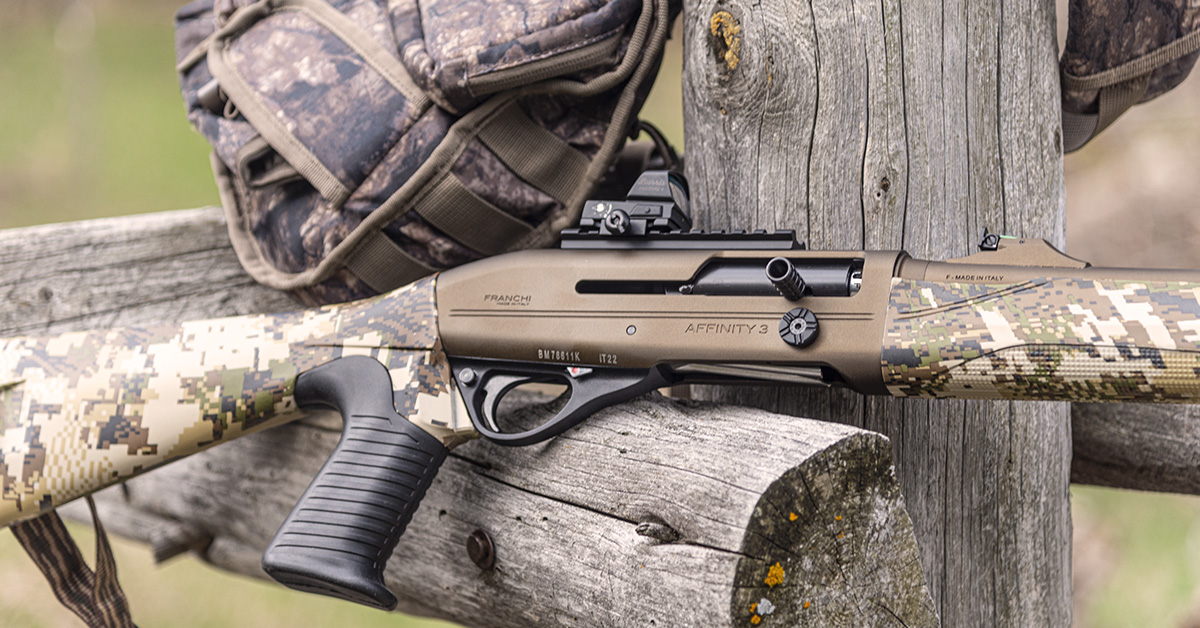
The furniture comes dressed in GORE OPTIFADE Subalpine camo — a color scheme that blends smartly with the Midnight Bronze Cerakote receiver and barrel.
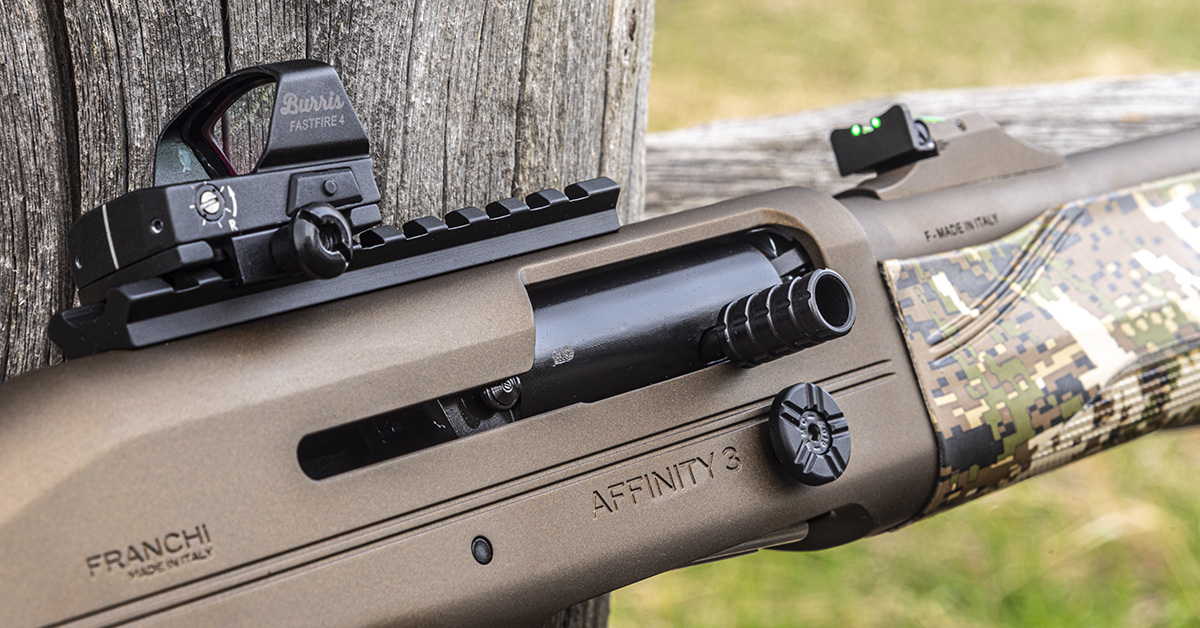
One of the highlights of the Affinity series is the Inertia Driven system. Designed to cycle a broad range of loads, this operating system is butter-smooth, always reliable, clean-running, and contributes mightily to the shotgun’s exquisite balance and swing. A large bolt handle and bolt release make for easy operation.
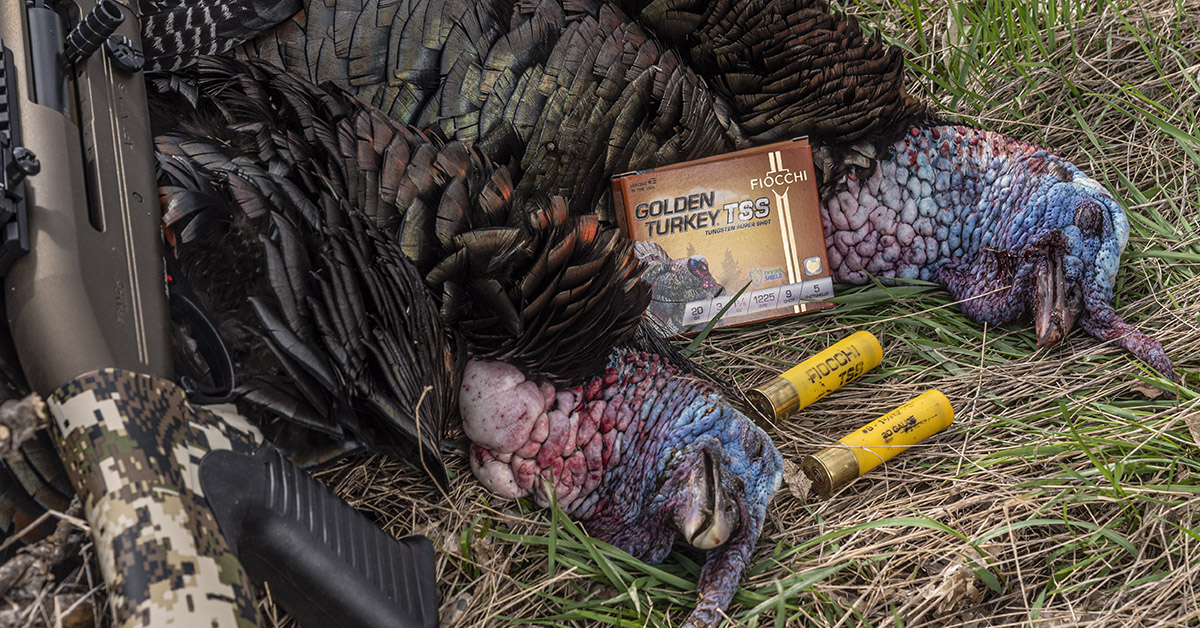
I’ve witnessed tremendous accuracy performance while testing several .223 Remington and .308 Winchester loads from Fiocchi over the last several months, so I was looking forward to seeing how the company’s Golden Turkey TSS shotshells would perform on the South Dakota prairie, where shot opportunities can range from in-your-face to way out there. In short, the Golden Turkey TSS exceeded expectations. As mentioned, the dense shot group at 40 yards dispelled any concerns that a 60-yard tom wouldn’t take a dirt nap with a well-aimed shot. Fiocchi offers the Golden Turkey TSS featuring 18 g/cc tungsten shot in sizes 7 and 9 for 12-, 20-, 28-, and .410 gauges sporting 3-inch chambers.

Although turkey vests have their place, wearing one on miles-long hikes on warm spring days can be grueling. For the ultimate in go-light, go-fast gear toting, the Ambush Sling Pack from ALPS OutdoorZ is the winner. Designed for the turkey hunter (although quite handy for big-game hunting as well) and offered in Mossy Oak Obsession or Realtree Timber, the Ambush Sling Pack boasts exterior and interior zippered compartments suitable for holding most everything you need for a half-day or full-day hunt. Standard features include an ambidextrous, multi-position shoulder strap, integrated box call pocket, detachable ThermaCELL holder with left- and right-side MOLLE attachment, shell loops, an exterior zippered mesh pocket, removeable diaphragm call pocket, and more.
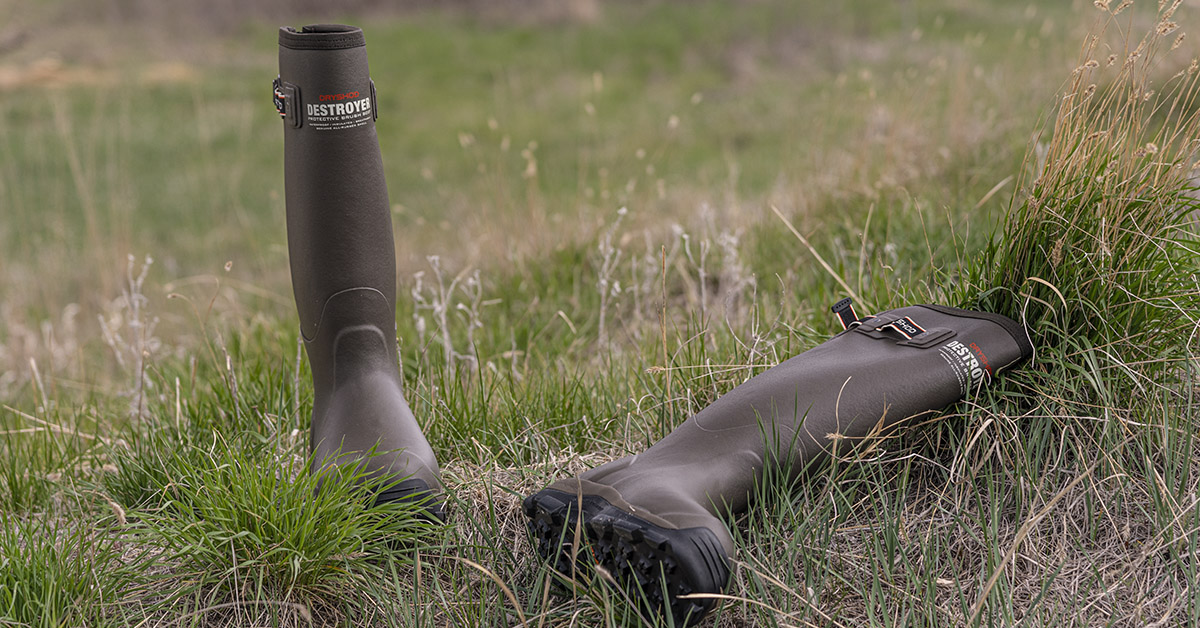
While I’ve never been a big fan of wearing rubber boots for most hunting conditions, Dryshod has certainly made 100-percent waterproof boots viable options that fit better, perform better, hold up better, and offer significantly better all-terrain traction than other brand waterproof boots I’ve worn over the years. One of the company’s boots that is right in the lane of the rough country hunter is the Destroyer Protective Brush Boot. These boots are two inches taller than standard Dryshod models, so you can go in a little deeper and enjoy extra leg shielding in the nasty stuff. Added to the extra length is a fabric-backed 1.8 mil rubber upper that protects from brush, briars, and even snake bites — a real consideration once spring temperatures rise. Equally important to hunters is the boot’s DS1 molded outsole and its aggressive tread design. The material and mechanical construction of these soles provide the kind of grip you want when traversing mud, rocks, and steep slopes. These are also one of the coolest rubber boots I’ve worn, due largely to the wicking airmesh lining that pulls moisture away from the skin and promotes airflow to keep boot temperatures down in warm weather.
Gear is a personal thing, and it takes some trial and error before we can usually dial it in for our particular hunting styles. I definitely drew aces in the equipment selection for this hunt.
